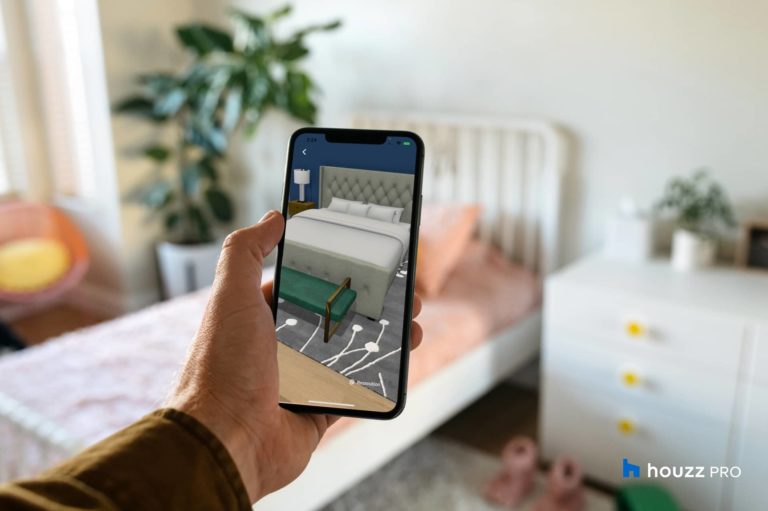
Opportunities in augmented reality are often divided between consumer-based endpoints (think: Snap Lenses) and enterprise productivity (think: Microsoft Hololens). But what about the space between? We’re talking about the less sexy but equally opportune ‘B2B2C’ space.
This under-exposed AR sub-segment includes enabling tools that equip businesses to offer AR to their customers. It includes AR platforms such as Snap’s Lens Studio, which enables consumer brands to create AR lenses to promote themselves and interact with their target customers.
B2B2C also includes tools that help businesses serve day-to-day customers. That’s everything from visualizing a kitchen remodel to troubleshooting your busted WiFi. To further illustrate AR’s B2B2C opportunity (say that three times fast), here are three ways it’s playing out today.
Will Mobile AR Revenues Reach $26 Billion by 2025?
1. Streem Remote Home Services
Streem lets home services pros serve their customers through AR. It brings the industrial AR concept of remote assistance to customer support. Picture a cable company rep visually walking you through a router setup, versus disjointed and cumbersome voice-only guidance.
This also applies to home services like plumbing. Homeowners can be the eyes and ears of a remote pro, via upheld smartphone or tablet. They can then diagnose issues and offer instructions through voice and on-screen annotations. All in all, it can reduce costly technician visits.
Streem accomplishes this to the tune of 42% fewer visits. These include preliminary home visits to scope and price a given job. The result is cutting two visits down to one. And in less-invasive services like setting up your internet, it can mean cutting one visit down to none.
The model has broad applicability to several home services. In fact, Streem has even expanded into real estate. The idea is that it can help agents offer live virtual showings by appointment, where they walk homebuyers through a given house and answer their questions.
Underscoring the opportunity, Streem’s value was amplified in the Covid era by supporting socially-distanced home services. Even as Covid retreats, there’s accelerated demand for remotely-fulfilled services. Streem now works with Lowes for AR-guided floor measurements.
Regardless of the service, be it plumbing or internet (types of tubes), Streem taps into a large addressable market, including users that are comfortable with a smartphone but not savvy enough for DIY troubleshooting. Think of this as a sort of Geek Squad 2.0 for home services.
Case Study: Streem Taps the ‘B2B2C’ Opportunity
2. Houzz Renovation Planner
Houzz recently launched an AR feature that lets home service pros display finished projects to customers. It involves life-sized floor plans that are digitally overlayed on physical spaces to help homeowners get a sense of the end result and make design choices accordingly.
We’re talking walls, windows, cabinets, islands, and other design choices like colors and textures. Of course, visualizing products in one’s space isn’t new; it’s a Covid-accelerated technology to get more IRL dimension when shopping online for everything from couches to cosmetics.
Houzz itself has offered furniture visualization for years with its View in My Room 3D. But what’s different about its latest play is to visualize entire floor plans. This lets it take a bite at big renovation projects, letting home services pros portray final results on a room-by-room basis.
That brings us back to the virtues of B2B2C. It’s a vessel to bring AR to mainstream consumers through the professionals who are more motivated to adopt it. That can accelerate the go-to-market strategy of any AR tool that’s meant to end up in consumers’ hands.
As for that pro motivation, it stems from competitive differentiation. Pros that offer AR visualization can gain an edge in marketing and customer interactions. Moreover, AR can help them achieve operational efficiencies, such as avoiding having to redo work downstream.
In other words, visually-informed customer decisions are less likely to go wrong. We’ve seen this concept play out in e-commerce when AR reduces product returns due to a more confident initial purchase. Home renovation pros can benefit from a higher-stakes version of that.
AR & Shopping Collide, Part VI: Houzz
3. Niantic Sponsorship Program
Our third example is a bit of a departure: Pokémon Go. The game’s maker Niantic has begun to diversify its revenue model beyond in-app purchases to tap into local marketing. Its Sponsorship Platform lets local businesses pay to drive foot traffic to their doorsteps.
The way this works is that local businesses position their real-world locations as in-game waypoints such as gyms and Pokéstops. They can then stimulate in-game raids by choosing when Pokémon hatch – even choosing days and times to boost foot traffic (think: slow hours).
In this way, sponsorship isn’t contrived but aligned with gameplay. Niantic reports that 73 percent of players deviate from regular walking routes – sometimes to sponsored locations – to achieve in-game milestones. 84 percent interacted with businesses and 58 percent transacted.
Moreover, players can work up a hunger through Pokémon Go’s migratory play, making sponsorship a natural fit for fast food, convenience, and coffee shops. In fact, brands like Circle K and 7-Eleven have boosted revenue as high as 10.5 percent through sponsorship campaigns.
Beyond these ROI signals, players associate brands with positive experiences with the game — in some cases to fuel them for play. The bottom line is that AR is still young as a marketing vehicle and B2B2C tactic. We’ll see it continue to branch in several directions like the above.






